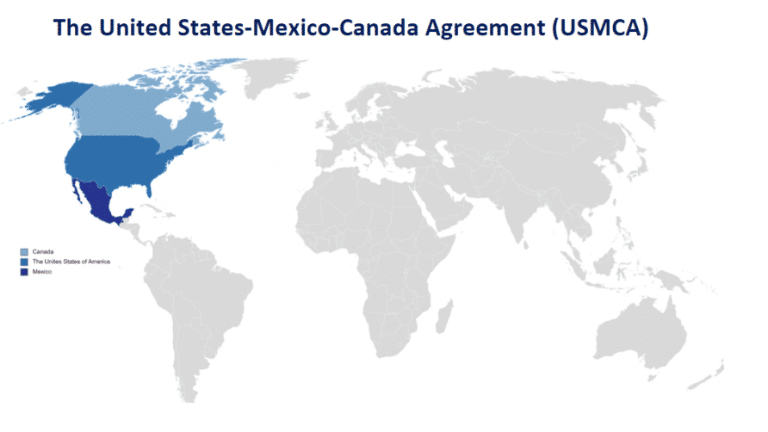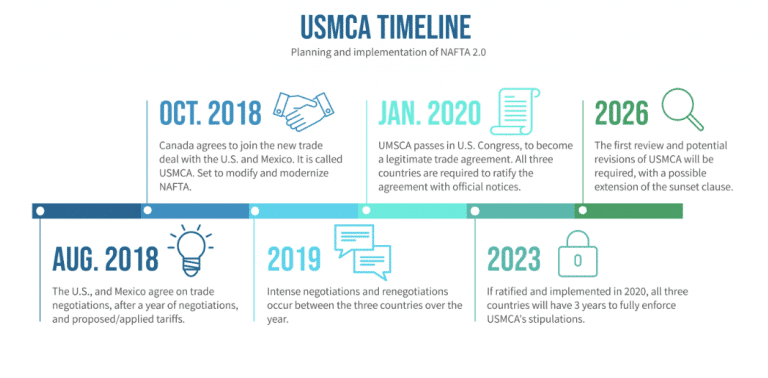If you are doing research on trade agreements or free trade you surely would have come across mentions of influential agreements such as the United States-Mexico-Canada Agreement, known more commonly as USMCA.
Trade agreements are an essential component of reducing the barriers and restrictions that come with international trade, they both encourage and make international trade easier for the countries involved. While there are hundreds of enforced trade agreements today, some are larger and have more influence over international trade than others, the United States-Mexico-Canada Agreement (USMCA) is an example of this.
What is USMCA?
The United States-Mexico-Canada Agreement (USMCA) is a free trade agreement between Canada, Mexico, and the United States that entered into force on July 1, 2020. This agreement was reached to modernize the 25-year-old NAFTA into a 21st century, high-standard agreement.

This is a multilateral free trade agreement that was created with the intention of benefiting trade flows in North America while bolstering channels for investors, exporters, importers, non-governmental groups, and governments to seek to resolve problems and disputes.
The USMCA is a win for the three countries involved as it supports mutually beneficial trade which leads to freer markets, fairer trade, and robust economic growth in North America.
The agreement reduces costs and makes cross-border transitions easier and more predictable. USMCA prohibits custom duties on products distributed electronically, enhances protection and enforcement of IP rights, ensures fair and transparent treatment when supplying cross-border services and encourages regulatory compatibility and cooperation.
History and Negotiations
The USMCA resulted from the renegotiation of the former North America Free Trade Agreement (NAFTA), which had been enacted in 1994. The negotiations to modernize the previous agreement began in 2017, and primarily focuses on provisions surrounding auto exports, steel and aluminum tariffs, and the dairy, egg, and poultry markets.
The three countries came to a formal agreement on October 1, 2018, and the USMCA was proposed during the G20 summit the following month. Following further negotiations over the following year, a revised version of the agreement was signed by United States President Donald Trump, Mexican President Enrique Peña Nieto, and Canadian Prime Minister Justin Trudeau was signed on December 10, 2019. The agreement was then ratified by all three countries in 2020 and came into effect on July 1, 2020.
The countries now have until 2023, 3 years after the date it came into effect to fully enforce the USMCA’s stipulations.
The agreement will receive a formal review in 2025-2026.

(USMCA Timeline: Planning and Implementation of NAFTA 2.0)
Agreement highlights
The USMCA aims to facilitate and support trade between the participating countries, encouraging free and fair trade and further driving economic growth in North America. While the USMCA has broad impacts on all kinds of trade between the involved countries, 5 of the most agreements most important provisions include the following:
Dairy and Agriculture
- The USMCA will increase U.S. farmers’ access to the Canadian dairy market by raising the amount of U.S. goods that can be exported to Canada tariff-free. This will allow the U.S. tariff-free access to up to 3.6% of the Canadian dairy market. The number of tariff-free exports allowed for some poultry products will also be expanded.
Automobiles
- One of the most significant portions of the USMCA stipulates new trade regulations for automobiles and automotive parts. Under NAFTA, cars and trucks with at least 62.5% of their components manufactured in one of the three participating countries could be sold free of tariffs. The USMCA increases that minimum requirement to 75%. At the same time, the USMCA stipulates minimum wages for workers in the automotive manufacturing process: 40-45% of the work done on eligible vehicles must be accomplished by workers earning at least $16 (USD) per hour.
Intellectual Property
- The USMCA increases intellectual property protections. Among other changes to trade policy, the new agreement extends the copyright period to 70 years beyond the life of the creator, an increase of 20 years in some cases. The USMCA also addresses new products that weren’t around when NAFTA was written in the early 1990s. The USMCA prohibits tariffs on digital music, e-books, and other similar digital products. The agreement also establishes copyright safe harbor for internet companies, meaning they can’t be held liable for copyright infringements of their users if they make good faith efforts to stop infringement.
Sunset Provision
- Unlike NAFTA, the USMCA is set to expire after 16 years unless it is renewed. All three nations are required to come together for a joint review every 6 years. The agreement is not automatically terminated if one party refuses to renew it at one of these joint reviews. Instead, the nations are required to meet every year for the following 10 years to resolve the issues blocking renewal. The agreement expires if no agreement is reached in those 10 years.
Labor
- The USMCA sets up an independent investigatory panel that can investigate factories accused of violating workers’ rights and stop shipments from factories found to be in violation of labor laws. In addition, Mexico says it will enact a wide array of labor reforms to make it easier for workers to unionize and stop violence and other abuses of workers. These provisions are meant to achieve two goals: to improving working conditions for Mexico’s workers and create a more even playing field between U.S. and Mexican factories because Mexican wages are likely to rise
Other key agreement highlights also include provisions on rules of origin to encourage more goods and materials to be manufactures in the United States and ensure the benefits of USMCA flow to North American workers, new commitments for market access, to address non-tariff barriers related to trade in remanufactured goods, import licensing, and export licensing, and finally, provisions surrounding small businesses to cut red tape and make it easier for small businesses to tap into foreign markets and participate in cross-border trade.
Impact of the Agreement
The agreement is playing a positive role in boosting trade flows, as well as improving bilateral and trilateral relations between the participants.
Under the United States-Mexico-Canada Agreement, trade is bouncing back from pre-COVID-19 levels, averaging a 6% increase across the region from 2019 to 2021. With a record 75% of Canadian and Mexican imports coming from the United States, both countries are both the US’s largest export market and the US’s largest trading partners, accounting for more than twice US trade than with China.
In 2021, the total trade flows between the three countries reached $1.3 Trillion, and 2022 seemingly had a similar trajectory. Trade in the region reached $642.6 billion in the first five months of 2022 alone, showing a 23% increase from 2021.
However, there have also been challenges, and more are expected to come. Disputes have arisen between the three countries over the past 2 years, and with USMCA dispute panels having been previously established to address issues on Canadian dairy tariffs, US solar panel duties and, most recently, rules of origin for vehicles.
Despite these challenges, the agreement is showing obvious mutual benefits for the countries involved and the agreement is maintaining its promise of free and fair trade for the region.
More from ResearchFDI:



